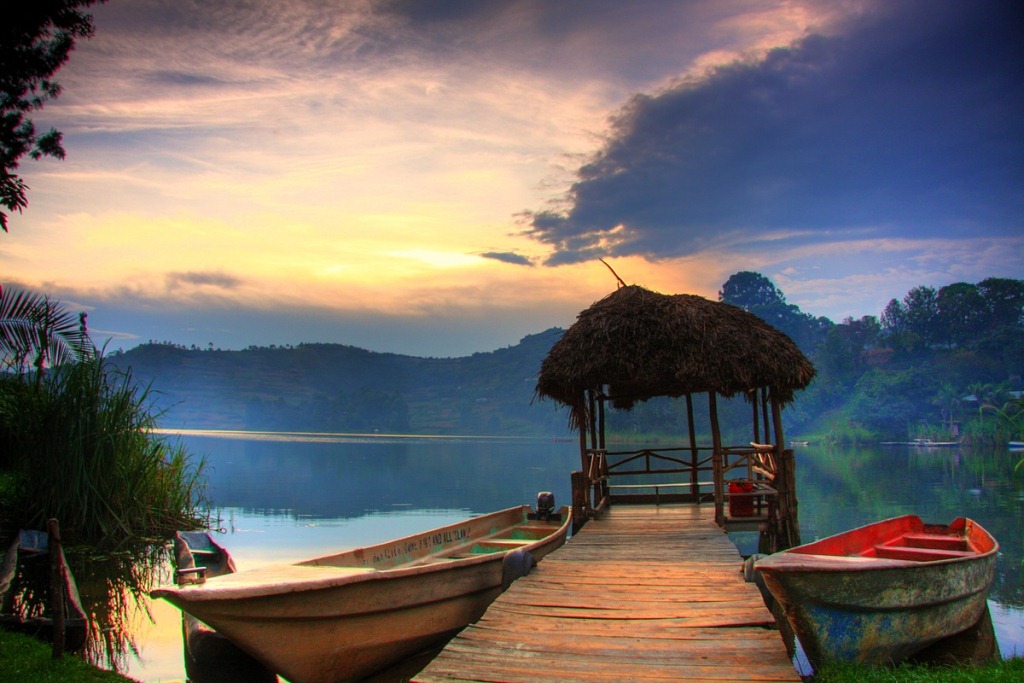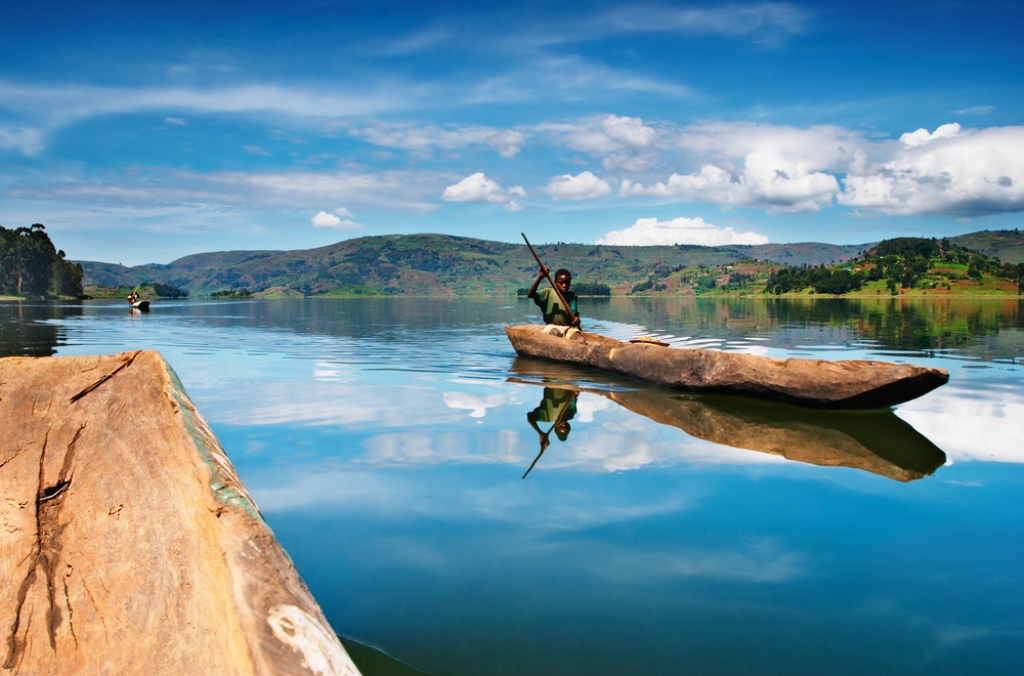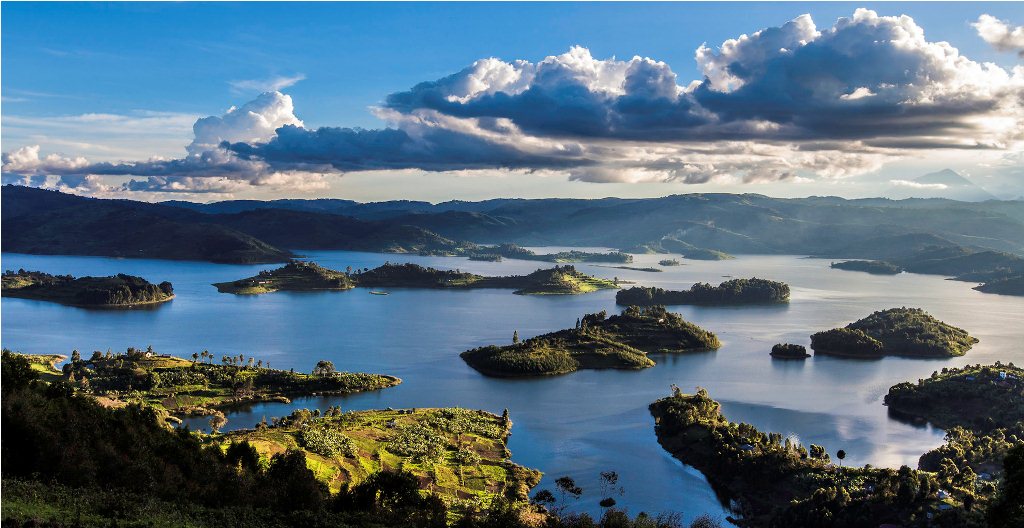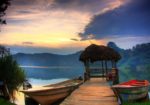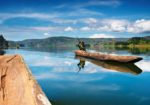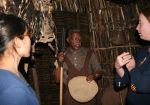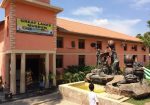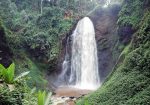Lake Bunyonyi (“Place of many little birds”) lies in south western Uganda between Kisoro and Kabale close to the border with Rwanda. Located at 1,962 m above sea level, it is about 25 km long and 7 km wide. The depth of the lake is rumored to vary between 44 m and 900 m, which if true would make the lake the second deepest in Africa. It is one of the few lakes in the region that is free of bilharzia and safe for swimming. The lake appears on the 5,000 Ugandan shilling note under the title “lake bunyonyi and terraces”.
Towns on its shores include Kyevu and Muko, while its 29 islands include Punishment Island and Bushara Island. It is a popular location for watersports and is known for the surrounding terraced hillsides. It is popular with both foreign and domestic tourists and there are a wide variety of tourist accommodations.
Lake Bunyonyi is a body of water seven kilometres west from Kabale Town, southwestern Uganda. It is 25 km long and 7 km wide, covering an area of 61 square kilometres. The lake’s altitude is 1,950 m, and it is surrounded by hills that are 2,200 to 2,478 m high and intensely cultivated.
Its 29 islands are concentrated in the central part. These islands have few settlements, they are mostly used for tourist facilities and for a secondary and a primary school.
The data on the lake’s maximum depth varies, from 44 m to 900 m in parts. If the latter is true, Lake Bunyonyi is the second deepest lake in Africa. The temperature on the surface rises to 25 degrees Celsius. In the beginning of the 20th century, fish were introduced to the lake and in the 1930s fishing became profitable. Unfortunately in the 1960s the fish died massively as a result of a violent shallow mixing, likely caused by wind. Subsistence fishing prevailed in the lake, people mostly caught clarias species – the lake’s depth and stratification makes it difficult for the breeding of the common Ugandan species Nile Perch and Tilapia. Nevertheless, 300,000 Nile Tilapias and Clarias fish were released in the lake at the end of 2002. Also present in the lake are Mud fish, Cray fish and Mirrowcarp – and plenty of their predators, otters.
The lake’s main centre is Bufuka Village. The area’s inhabitants are from the Bakiga and the Batwa tribes.
Main islands
Akampene = Punishment Island
The Bakiga used to leave unmarried pregnant girls on this small island with a tree – to die of hunger or while trying to swim to the mainland (swimming skills were rare). This was to educate the rest, to show them not to do the same. A man without cows to pay the bridewealth could go to the island and pick up a girl. The practice got abandoned in the first half of the 20th century. Although this practice has been abandoned, it is still possible to find women who were picked up from punishment island today.
Bushara Island
This island is the home of Lake Bunyonyi Development Company, an organisation with strong links to Church of Uganda, the main church of the lake area. They use tourism to generate funds for several development projects around Bunyonyi. The island has many luxury tents, chalets, and also campsites for tourists to stay on. It is also possible to rent out canoes and sailboats with a view to paddling to one of the other islands.
The striking feature of the island is its forest, a demonstration of the most appealing attribute of the eucalyptus tree: an exceptionally fast growth rate. The hills around Bunyonyi used to feature many forests but overpopulation led to them being cut down to create land for agriculture needs. Eucalypti have been imported to improve the situation. But eucalyptus plants may also have a negative effect: they can soak everything useful in the soil, leaving it more or less barren.
Kyahugye Island
Kyahugye Island is approximately 30ha in size and also the nearest to the mainland – a mere 5-minute boat ride away. It is surrounded by a 1-2m wide strip of reeds interspersed with papyrus. The Island has many tree species including Eucalyptus sp., Pinus sp., Alnus sp., and Cuprssus sp., these forming a wide perimeter around it. The vegetation on the Island falls into four categories namely bush, open fallows, tree plantations and natural vegetation. The hilltop is flat and has been developed for tourists. There are chalets and campsites for accommodation, and a well stocked bar and restaurant. From the top of the Island, there are spectacular views of the surrounding terraced hillsides, the calm waters of Lake Bunyonyi, and the neighboring Islands. On a clear day, Mt. Muhabura can be seen in the distance. Tourist activities like Nature walks, Birding walks, Dugout Canoe Treks, Community visits, Mountain Climbing, etc can be organized.
Bwama and Njuyeera (Sharp’s Island)
In 1921, an English missionary called Dr Leonard Sharp came to this part of Uganda and in 1931 established a leprosy treatment centre on the then uninhabited Bwama island . A church, patient quarters (model villages) and a medical facility were built, while Sharp settled on Njuyeera Island (probably meaning ‘white cottage’, after the similarity of the doctor’s small white house to Sharp’s father’s house in Shanklin, now The White House Hotel). The rationale of the leprosy colony was that of ‘voluntary segregation’, where the provision of a happy community to live in would attract leprosy sufferers, so removing them from the communities where they might infect others.
The buildings of the hospital are now used by a boarding secondary school which attracts students from the entire region. There is also a primary school but no village on the island.
Bucuranuka = Upside Down
The legend says that this island killed many people. About twenty were once brewing local sorghum beer there. An old woman was passing by and she said: “Can you give me some local beer?” They wrongly thought that she was a beggar they knew. They refused her: “Get lost, beggar! Get lost!!!” The old woman asked: “So you will not even give me a sip? Can I at least get somebody to take me to the mainland?” They answered: “Yes, because we are fed up with you!” They chose a young guy to take her over. When they reached the shore and the guy was just beginning to return, the island turned upside down. All died, only a chicken flew away and survived.

